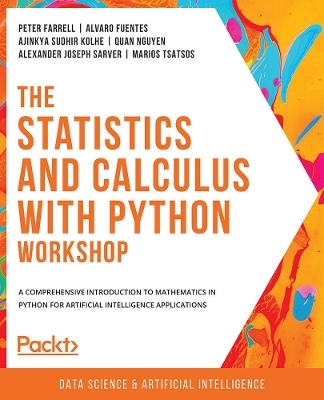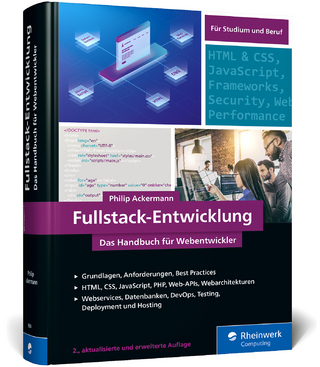
The Statistics and Calculus with Python Workshop
Packt Publishing Limited (Verlag)
978-1-80020-976-3 (ISBN)
The book begins by giving you a high-level overview of the libraries you'll use while performing statistics with Python. As you progress, you'll perform various mathematical tasks using the Python programming language, such as solving algebraic functions with Python starting with basic functions, and then working through transformations and solving equations. Later chapters in the book will cover statistics and calculus concepts and how to use them to solve problems and gain useful insights. Finally, you'll study differential equations with an emphasis on numerical methods and learn about algorithms that directly calculate values of functions.
By the end of this book, you’ll have learned how to apply essential statistics and calculus concepts to develop robust Python applications that solve business challenges.Key Features
Discover how most programmers use the main Python libraries when performing statistics with Python
Use descriptive statistics and visualizations to answer business and scientific questions
Solve complicated calculus problems, such as arc length and solids of revolution using derivatives and integrals
What you will learnGet to grips with the fundamental mathematical functions in Python
Perform calculations on tabular datasets using pandas
Understand the differences between polynomials, rational functions, exponential functions, and trigonometric functions
Use algebra techniques for solving systems of equations
Solve real-world problems with probability
Solve optimization problems with derivatives and integrals
Who this book is forIf you are a Python programmer who wants to develop intelligent solutions that solve challenging business problems, then this book is for you. To better grasp the concepts explained in this book, you must have a thorough understanding of advanced mathematical concepts, such as Markov chains, Euler's formula, and Runge-Kutta methods as the book only explains how these techniques and concepts can be implemented in Python.
Peter Farrell learned to program from the Logo code in Seymour Paperts Mindstorms. A student introduced him to Python and he never looked back. In 2015, he self-published Hacking Math Class with Python on applying Python programming to learning and teaching high-school math. In 2019, No Starch Press published his second book, Math Adventures with Python. In his books, he also presents 21st-century topics, such as Cellular Automata, 3D Graphics, and Genetic Algorithms. Currently, he teaches Python and Math in the Dallas, Texas area. Alvaro Fuentes is a senior data scientist with a background in applied mathematics and economics. He has more than 14 years of experience in various analytical roles and is an analytics consultant at one of the ‘Big Three’ global management consulting firms, leading advanced analytics projects in different industries like banking, technology, and consumer goods. Alvaro is also an author and trainer in analytics and data science and has published courses and books, such as 'Become a Python Data Analyst' and 'Hands-On Predictive Analytics with Python'. He has also taught data science and related topics to thousands of students both on-site and online through different platforms such as Springboard, Simplilearn, Udemy, and BSG Institute, among others. Ajinkya Sudhir Kolhe is a programmer working for a tech company in the Bay area. He holds a M.S. in Computer Science and has experience in the tech industry of 5+ years. His area of interests include problem solving, analytics and applications in Python. Quan Nguyen is a Python programmer and machine learning enthusiast. He is interested in solving decision-making problems under uncertainty. Quan has authored several books on Python programming and scientific computing. He is currently pursuing a Ph.D. degree in computer science at Washington University in St. Louis, researching Bayesian methods in machine learning. Alexander Joseph Sarver is an ambitious data scientist and content creator with 6 years of mathematical teaching experience. Marios Tsatsos has 8+ years of experience in research in Physics, analytical thinking, modeling, problem solving and decision making.
Table of Contents
Fundamentals of Python
Python's Main Tools for Statistics
Python's Statistical Toolbox
Functions and Algebra with Python
More Mathematics with Python
Matrices and Markov Chains with Python
Doing Basic Statistics with Python
Foundational Probability Concepts and Their Applications
Intermediate Statistics with Python
Foundational Calculus with Python
More Calculus with Python
Intermediate Calculus with Python
| Erscheinungsdatum | 21.08.2020 |
|---|---|
| Verlagsort | Birmingham |
| Sprache | englisch |
| Maße | 191 x 235 mm |
| Themenwelt | Mathematik / Informatik ► Informatik ► Programmiersprachen / -werkzeuge |
| ISBN-10 | 1-80020-976-2 / 1800209762 |
| ISBN-13 | 978-1-80020-976-3 / 9781800209763 |
| Zustand | Neuware |
| Haben Sie eine Frage zum Produkt? |
aus dem Bereich


